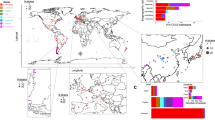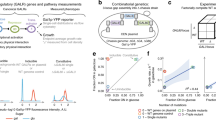Abstract
The evolution of novel traits can involve many mutations scattered throughout the genome1,2. Detecting and validating such a suite of alleles, particularly if they arose long ago, remains a key challenge in evolutionary genetics1,2,3. Here we dissect an evolutionary trade-off of unprecedented genetic complexity between long-diverged species. When cultured in 1% glucose medium supplemented with galactose, Saccharomyces cerevisiae, but not S. bayanus or other Saccharomyces species, delayed commitment to galactose metabolism until glucose was exhausted. Promoters of seven galactose (GAL) metabolic genes from S. cerevisiae, when introduced together into S. bayanus, largely recapitulated the delay phenotype in 1% glucose–galactose medium, and most had partial effects when tested in isolation. Variation in GAL coding regions also contributed to the delay when tested individually in 1% glucose–galactose medium. When combined, S. cerevisiae GAL coding regions gave rise to profound growth defects in the S. bayanus background. In medium containing 2.5% glucose supplemented with galactose, wild-type S. cerevisiae repressed GAL gene expression and had a robust growth advantage relative to S. bayanus; transgenesis of S. cerevisiae GAL promoter alleles or GAL coding regions was sufficient for partial reconstruction of these phenotypes. S. cerevisiae GAL genes thus encode a regulatory program of slow induction and avid repression, and a fitness detriment during the glucose–galactose transition but a benefit when glucose is in excess. Together, these results make clear that genetic mapping of complex phenotypes is within reach, even in deeply diverged species.
This is a preview of subscription content, access via your institution
Access options
Subscribe to this journal
Receive 51 print issues and online access
$199.00 per year
only $3.90 per issue
Buy this article
- Purchase on Springer Link
- Instant access to full article PDF
Prices may be subject to local taxes which are calculated during checkout




Similar content being viewed by others
References
Orr, H. A. The genetic theory of adaptation: a brief history. Nature Rev. Genet. 6, 119–127 (2005)
Rockman, M. V. The QTN program and the alleles that matter for evolution: all that’s gold does not glitter. Evolution 66, 1–17 (2012)
Pritchard, J. K., Pickrell, J. K. & Coop, G. The genetics of human adaptation: hard sweeps, soft sweeps, and polygenic adaptation. Curr. Biol. 20, R208–R215 (2010)
Savolainen, O., Lascoux, M. & Merilä, J. ; Savolainen. Ecological genomics of local adaptation. Nature Rev. Genet. 14, 807–820 (2013)
Nadeau, N. J. & Jiggins, C. D. A golden age for evolutionary genetics? Genomic studies of adaptation in natural populations. Trends Genet. 26, 484–492 (2010)
Schraiber, J. G., Mostovoy, Y., Hsu, T. Y. & Brem, R. B. Inferring evolutionary histories of pathway regulation from transcriptional profiling data. PLoS Comput. Biol. 9, e1003255 (2013)
Caudy, A. A. et al. A new system for comparative functional genomics of Saccharomyces yeasts. Genetics 195, 275–287 (2013)
Bullard, J. H., Mostovoy, Y., Dudoit, S. & Brem, R. B. Polygenic and directional regulatory evolution across pathways in Saccharomyces. Proc. Natl Acad. Sci. USA 107, 5058–5063 (2010)
Venturelli, O. S., Zuleta, I., Murray, R. M. & El-Samad, H. Population diversification in a yeast metabolic program promotes anticipation of environmental shifts. PLoS Biol. 13, e1002042 (2015)
Wang, J. et al. Natural variation in preparation for nutrient depletion reveals a cost-benefit tradeoff. PLoS Biol. 13, e1002041 (2015)
New, A. M. et al. Different levels of catabolite repression optimize growth in stable and variable environments. PLoS Biol. 12, e1001764 (2014)
De Deken, R. H. The Crabtree effect: a regulatory system in yeast. J. Gen. Microbiol. 44, 149–156 (1966)
Peng, W., Liu, P., Xue, Y. & Acar, M. Evolution of gene network activity by tuning the strength of negative-feedback regulation. Nature Commun. 6, 6226 (2015)
Scannell, D. R. et al. The awesome power of yeast evolutionary genetics: new genome sequences and strain resources for the Saccharomyces sensu stricto genus. G3 1, 11–25 (2011)
Nair, N. U. & Zhao, H. Mutagenic inverted repeat assisted genome engineering (MIRAGE). Nucleic Acids Res. 37, e9 (2009)
Storici, F. & Resnick, M. A. The delitto perfetto approach to in vivo site-directed mutagenesis and chromosome rearrangements with synthetic oligonucleotides in yeast. Methods Enzymol 409, 329–345 (2006)
Warringer, J. et al. Trait variation in yeast is defined by population history. PLoS Genet. 7, e1002111 (2011)
Livak, K. J. & Schmittgen, T. D. Analysis of relative gene expression data using real-time quantitative PCR and the 2 − Δ Δ C t method. Methods 25, 402–408 (2001)
Bradley, R. K. et al. Fast statistical alignment. PLoS Comput. Biol. 5, e1000392 (2009)
Haddrill, P. R., Bachtrog, D. & Andolfatto, P. Positive and negative selection on noncoding DNA in Drosophila simulans. Mol. Biol. Evol. 25, 1825–1834 (2008)
Stoletzki, N. & Eyre-Walker, A. Estimation of the neutrality index. Mol. Biol. Evol. 28, 63–70 (2011)
Charlesworth, J. & Eyre-Walker, A. The McDonald-Kreitman test and slightly deleterious mutations. Mol. Biol. Evol. 25, 1007–1015 (2008)
He, B. Z., Holloway, A. K., Maerkl, S. J. & Kreitman, M. Does positive selection drive transcription factor binding site turnover? A test with Drosophila cis-regulatory modules. PLoS Genet. 7, e1002053 (2011)
Rand, D. M. & Kann, L. M. Excess amino acid polymorphism in mitochondrial DNA: contrasts among genes from Drosophila, mice, and humans. Mol. Biol. Evol. 13, 735–748 (1996)
Nei, M. Molecular Evolutionary Genetics (Columbia Univ. Press, 1987)
Nei, M. & Li, W. H. Mathematical model for studying genetic variation in terms of restriction endonucleases. Proc. Natl Acad. Sci. USA 76, 5269–5273 (1979)
Acknowledgements
This work was supported by National Institutes of Health GM087432 to R.B.B. and a Hellman Graduate Fellowship from the University of California Berkeley to J.I.R. We thank A. Arkin for his advice and resources; J. Rine for yeast strains; O. Venturelli for technical expertise; and A. Flamholz, J. Schraiber, and P. Shih for discussions.
Author information
Authors and Affiliations
Contributions
J.I.R. and R.B.B. designed experiments, J.I.R. and K.C.C. conducted experiments, J.I.R. analysed data, and J.I.R. and R.B.B. wrote the paper.
Corresponding author
Ethics declarations
Competing interests
The authors declare no competing financial interests.
Extended data figures and tables
Extended Data Figure 1 Divergence in the S. cerevisiae diauxic lag trait is specific to growth in glucose–galactose medium.
Each trace reports growth of the indicated yeast inoculated into medium containing 1% glucose and 1% of the indicated secondary carbon source (n = 4, data representative of two independent experiments).
Extended Data Figure 2 The S. bayanus allele of the GAL1 and GAL10 promoters confers partial rescue of diauxic lag in S. cerevisiae in 1% glucose–galactose medium.
a, Data are as in Fig. 3b, except that the yellow curve reports growth of an S. cerevisiae strain harbouring the GAL1 and GAL10 promoters from S. bayanus (n ≥ 12). b, Each bar reports the GMR of the indicated strain over the time course shown in a. Error bars, s.e.m.; asterisk indicates a significantly different rate (P < 1 × 10−15, Wilcoxon rank-sum) between the transgenic swap strain and wild-type S. cerevisiae. Each set of data is representative of the result of two independent experiments.
Extended Data Figure 3 Epistasis between S. cerevisiae GAL gene alleles swapped into S. bayanus, in 1% glucose–galactose medium.
Each bar reports the ratio of the GMR to that of wild-type S. bayanus, subtracted from 1, over a time course of the indicated strain inoculated into medium containing 1% glucose and 1% galactose. The first to fourth bars, and the last bar, are from Fig. 3c; each of the remaining bars reports results from an S. bayanus strain harbouring S. cerevisiae alleles at the indicated combination of GAL loci (n ≥ 8, data representative of two independent experiments). Symbols and analyses are as in Fig. 3c.
Extended Data Figure 4 S. bayanus strains harbouring S. cerevisiae alleles of all seven GAL loci, inoculated into 1% glucose–galactose medium, deplete growth media of galactose.
The first bar reports galactose concentration in medium before inoculation, and the remaining bars report concentrations after growth time courses, in the experiments in Fig. 3b (n = 3 biological replicates, each comprising 3 technical replicates).
Extended Data Figure 5 In pure galactose medium, S. cerevisiae alleles of GAL loci are sufficient for increased biomass accumulation and, in the case of protein-coding regions, slow growth.
a, Each trace reports growth of an S. bayanus strain harbouring S. cerevisiae alleles of all seven GAL genes, or a wild-type control, inoculated into medium containing 2% galactose (n ≥ 8). b, Each bar reports maximum growth rate from the respective time course in a. Error bars, s.e.m.; asterisks indicate values significantly different (P < 0.05, Wilcoxon rank-sum) from wild-type S. bayanus. c, Each bar reports growth yield from the respective time course in a. Error bars, s.e.m.; asterisks indicate values significantly different (P < 0.05, Wilcoxon rank-sum) from wild-type S. bayanus. Each set of data is representative of the result of two independent experiments.
Supplementary information
Supplementary Table 1
This file contains the strains used in this study. (XLSX 41 kb)
Supplementary Table 2
This file shows the qPCR primers and cycling conditions used in this study. (XLSX 38 kb)
Rights and permissions
About this article
Cite this article
Roop, J., Chang, K. & Brem, R. Polygenic evolution of a sugar specialization trade-off in yeast. Nature 530, 336–339 (2016). https://doi.org/10.1038/nature16938
Received:
Accepted:
Published:
Issue Date:
DOI: https://doi.org/10.1038/nature16938
This article is cited by
-
Role of Noise-Induced Cellular Variability in Saccharomyces cerevisiae During Metabolic Adaptation: Causes, Consequences and Ramifications
Journal of the Indian Institute of Science (2020)
-
Harmonious genetic combinations rewire regulatory networks and flip gene essentiality
Nature Communications (2019)
-
A non-linear model of hydrogen production by Caldicellulosiruptor saccharolyticus for diauxic-like consumption of lignocellulosic sugar mixtures
Biotechnology for Biofuels (2018)
-
Genetic dissection of interspecific differences in yeast thermotolerance
Nature Genetics (2018)
Comments
By submitting a comment you agree to abide by our Terms and Community Guidelines. If you find something abusive or that does not comply with our terms or guidelines please flag it as inappropriate.



